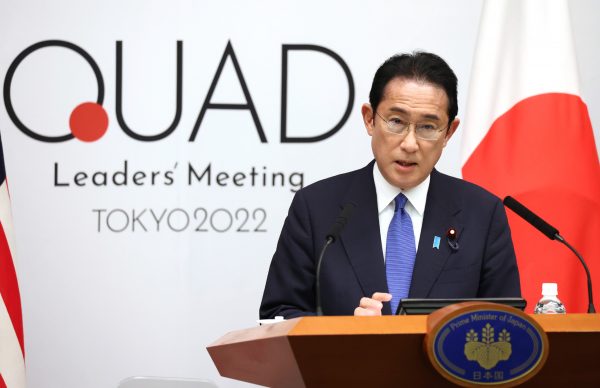This served as an occasion for the United States and Japan to grow their bilateral economic security cooperation and present a blueprint to advance former Japanese prime minister Shinzo Abe’s vision for a Free and Open Indo-Pacific (FOIP).
Arguably the finest global statesman of the last decade, the late Abe articulated the vision for the FOIP, envisaging a region of free and open commerce. But Kishida has correctly identified a need for ‘realism’ in advancing this vision. For the FOIP to flourish it needs to transition from a regional cause into a global phenomenon backed by credible diplomatic, economic and military force.
Advancing the FOIP is the cornerstone of the US–Japan policy to deter Chinese aggression. The Indo-Pacific is the most consequential region in the world, accounting for more than half of the global economy, commerce and population. In light of this, the United States and Japan need to work together with Australia and India — the other two nations of the Quad — to firmly establish the primacy of the FOIP in preserving global peace, prosperity and security.
In 2023, Japan will host the G7, India the G20, Australia the Quad Leaders’ Summit and the United States will host the Asia Pacific Economic Cooperation meeting. The Quad should use these gatherings to coordinate across economic, security and public diplomacy domains.
In conjunction with the Quad, the United States and Japan should facilitate increased global coordination. To do so, the G7 should grow into the G10 by including India, Australia and the European Union as formal members.
Neither the United States nor Japan alone can out-compete the extensive economic reach of China in the Indo-Pacific. At the same time, the Indo-Pacific cannot sustain its freedom and openness unless it is integrated with the US economy.
The only solution lies in collectively binding the economies of the Indo-Pacific as a bulwark against Chinese state capitalism. This can be achieved by translating the FOIP vision into a trusted trade arrangement — but delivering on promises is something the Quad needs to work on.
Regional trade arrangements are necessary to shore up supply chains and diversify the manufacturing of critical goods. As the world’s largest economy, the United States can and must lead this effort. It should do so by focussing on energy and the digital economy and building upon the Indo-Pacific Economic Framework.
With Russia’s ongoing military conflict with Ukraine, the growing China–Russia nexus underscores the security threats in the Indo-Pacific. The Quad needs to act on the lessons learned from NATO’s response to Russia’s invasion of Ukraine — particularly the importance of the timely sharing of intelligence, munitions manufacturing and logistical capacities to sustain a protracted armed conflict. The AUKUS arrangement among the United States, the United Kingdom and Australia to build nuclear submarines in Australia is a promising start.
The Five Eyes — an intelligence alliance among Australia, Canada, New Zealand, the United Kingdom and the United States — should work to incorporate Japan as a member and forge a closer relationship with India. Continued collaboration with South Korea and France — two countries with key security interests in the region — is also critical.
The United States and Japan must improve the quantity and quality of the Quad’s manufacturing capacity. There are many ways to do this. Quad defence standards can be aligned with those of NATO. Australia, Japan and New Zealand can bolster their manufacturing capacity for advanced armaments with contributions from India, South Korea and Taiwan. The Quad can also develop a collective strategy to wean India from its reliance on cheap Russian armaments and fully explore India’s capacity to be the FOIP’s arsenal for mass-produced conventional weapons.
The United States and Japan may seek to expand the Quad’s orbit by inviting guest nations to the next Quad Leaders’ Summit. South Korea, ASEAN nations, the European Union and other liberal nations with Indo-Pacific strategies will be eager participants. The Quad leaders may also consider establishing joint sessions at the East Asia Summit.
In 2023, the United States and Japan, alongside Australia and India, should cement the centrality of FOIP in sustaining the global rules-based order. The future trajectory of the Asian Century will hinge on the region’s ability to be ‘free and open’. Working together, the United States, Japan and allied nations can realise Shinzo Abe’s legacy of regional engagement. After all, a Free and Open Indo-Pacific is the bellwether for a free and open world.
Kaush Arha is Senior Fellow at the Atlantic Council and the Krach Institute for Tech Diplomacy at Purdue University. He is the former Senior Advisor for Strategic Engagement at USAID.

